Archive for May, 2011
The best dog breeds for small children
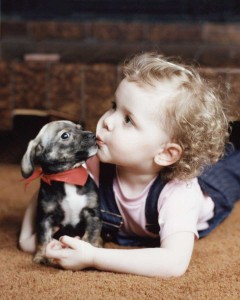 If your looking for a dog and you have a toddler in the house, don’t think that smaller is best. It may seem logical to you at first but small dogs are very fragile and your child could easily injure or even kill a dog by dropping it, stepping on it, shutting the door on it etc.
If your looking for a dog and you have a toddler in the house, don’t think that smaller is best. It may seem logical to you at first but small dogs are very fragile and your child could easily injure or even kill a dog by dropping it, stepping on it, shutting the door on it etc.
The very large dog breeds pose another problem. Even though very large dogs are usually very gentle, sturdy and robust, their size could injure your child. A Mastiff could easily knock down your child while trying to say “hello.”
It’s very difficult trying to stop a young child from poking, pulling, prodding and smothering a small puppy with hugs and kisses. Mid size dog breeds that have a very clam, tolerant and confident temperament may be a great choice if you have a small child in the home. Here are some breeds that you should consider.
- Beagle
- Boston Terrier
- Cocker Spaniel
- English Bulldog
- English Staffordshire Bull Terrier
- Wheaton Terrier
Always make sure that you’re in the room with the child and new puppy. Teach your child how to properly play with the puppy with his dog toys. Pay attention and make sure that your child and new puppy are bonding properly.
Cleaning your dog’s ears
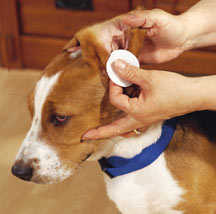 Dogs need to have their ears cleaned just like humans do. Usually a groomer will do this. However, you could do this yourself. Here are some easy instructions. First of all you’ll need:
Dogs need to have their ears cleaned just like humans do. Usually a groomer will do this. However, you could do this yourself. Here are some easy instructions. First of all you’ll need:
- Cotton swabs
- Pet ear cleaners
1. Use an ear wash that is formulated for cleaning. Here’s something very important to remember. Never use undiluted peroxide on your dogs ears as it will cause burning.
2. Soak a cotton ball thoroughly in the ear wash and squeeze out excess liquid.
3. Place the cotton ball in your dogs ear and gently rub up and down.
4. Allow your dog to shake off excess moisture. This is important in preventing ear infections.
5. Soak the tip of the cotton swab in the ear wash solution and run it along the nooks and crannies of your dog’s ears.
6. Avoid putting the cotton swab down your dog’s ear canal. Leave this for your veterinarian.
7. Never put any other pet medication in your dog’s ears.
That dreaded skunk
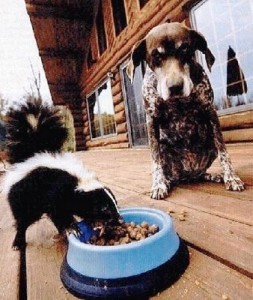 Your precious dog has been sprayed by a skunk. Besides holding your nose, what should you do? An effective skunk wash can be made from common ingredients that are found in your home. Have enough ingredients on hand for a few washings and you’ll want to have pet stain and odor removal products on hand as well.
Your precious dog has been sprayed by a skunk. Besides holding your nose, what should you do? An effective skunk wash can be made from common ingredients that are found in your home. Have enough ingredients on hand for a few washings and you’ll want to have pet stain and odor removal products on hand as well.
Here are two recipes for getting rid of that smell on your precious pooch!
The one with the smallest ratio of peroxide is recommended for dogs whose coat color may be affected adversely by the peroxide.
Recipe #1
1 quart of 3% hydrogen peroxide
1/4 cup of baking soda
1 teaspoon of liquid soap
Recipe #2
1 pint of 3% hydrogen peroxide
2/3 cups of baking soda
1 tablespoon of liquid soad
Mix this up at the time of use (the mixture must be fresh to work properly). Pour or sponge it on your dog. Knead it well into his coat. Be careful to keep the formula out of the dog’s eyes, nose and mouth; you can use a sponge to carefully wipe it on his/her face. Let it sit for five minutes then rinse with plain water. Be careful not to get it in the dogs eyes. Cover them with a wash cloth if needed. If a second dose is needed, mix a new batch from scratch. The mixture reacts with the chemicals in the skunk spray and oxidizes them. If the mixture is not fresh, the reaction will not work.
Do not store leftover shampoo.
Chlamydiosis in cats
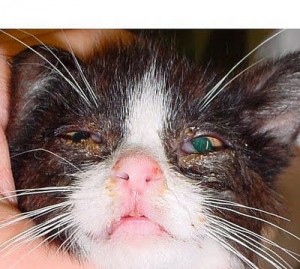 Chlamydiosis is a bacterial infection that affects cats. It causes the inside of the eyelid and the white part of the eye to become inflamed. Though it’s often relatively mild at first, affecting only one eye, this disease can progress to both eyes, leading to heavy discharge and such painful swelling that infected cats keeps their eyes half closed. The bacterium that causes Chlanydiosis is spread directly through cat to cat contact. The cats that are most susceptible are kittens and older cats that live in close proximity to lots of other felines. Pet medication such as antibiotics are very affective against this infection and a vaccine may also be useful in minimizing its affects. Left untreated, Chlanydiosis can become a chronic problem.
Chlamydiosis is a bacterial infection that affects cats. It causes the inside of the eyelid and the white part of the eye to become inflamed. Though it’s often relatively mild at first, affecting only one eye, this disease can progress to both eyes, leading to heavy discharge and such painful swelling that infected cats keeps their eyes half closed. The bacterium that causes Chlanydiosis is spread directly through cat to cat contact. The cats that are most susceptible are kittens and older cats that live in close proximity to lots of other felines. Pet medication such as antibiotics are very affective against this infection and a vaccine may also be useful in minimizing its affects. Left untreated, Chlanydiosis can become a chronic problem.
Dermal cysts on dogs
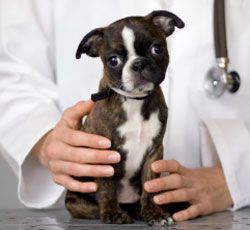 In general, dogs are prone to various kinds of dermal cysts, growths and skin tumors as they age. Many of these growths are benign but some could be cancerous. Always check your dog for any unusual or new growths. If you find any growth on your dog, the best course of action to take is to have your veterinarian examine her. Some of these growths can be diagnosed based on physical exam and inspection. Your vet may want to perform a “fine needle aspiration” to get a sample for microscopic analysis. This is a fairly easy and quick test that can often help to differentiate between a cyst, infection, malignant growth and a benign growth. At this time, your vet will advise you on the best way to proceed. Never use any pet medication on your dog unless checking with your vet first.
In general, dogs are prone to various kinds of dermal cysts, growths and skin tumors as they age. Many of these growths are benign but some could be cancerous. Always check your dog for any unusual or new growths. If you find any growth on your dog, the best course of action to take is to have your veterinarian examine her. Some of these growths can be diagnosed based on physical exam and inspection. Your vet may want to perform a “fine needle aspiration” to get a sample for microscopic analysis. This is a fairly easy and quick test that can often help to differentiate between a cyst, infection, malignant growth and a benign growth. At this time, your vet will advise you on the best way to proceed. Never use any pet medication on your dog unless checking with your vet first.
How to greet a dog
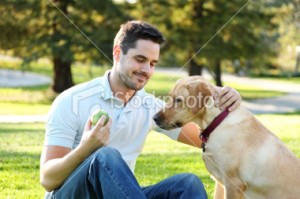 Dogs are social animals and a well trained dog is generally well behaved when meeting strangers. It helps to follow some basic steps when approaching any dog that you haven’t met before. First, it’s a good idea to ask the owner if it’s OK to great the dog. Always approach a dog when he’s on his dog leash. So you don’t intimidate the dog, bend on one knee beyond the reach of the dog. Remember, size matters and you are a big presence. Don’t stare directly at the dog and if you’re wearing a hat or sunglasses that may spook the dog, remove them slowly. Then, extend the back of a closed hand so the dog can sniff you. Once mutual contact is established, some mutual scratches under the chin and chest will help you become fast friends with you knew acquaintance.
Dogs are social animals and a well trained dog is generally well behaved when meeting strangers. It helps to follow some basic steps when approaching any dog that you haven’t met before. First, it’s a good idea to ask the owner if it’s OK to great the dog. Always approach a dog when he’s on his dog leash. So you don’t intimidate the dog, bend on one knee beyond the reach of the dog. Remember, size matters and you are a big presence. Don’t stare directly at the dog and if you’re wearing a hat or sunglasses that may spook the dog, remove them slowly. Then, extend the back of a closed hand so the dog can sniff you. Once mutual contact is established, some mutual scratches under the chin and chest will help you become fast friends with you knew acquaintance.